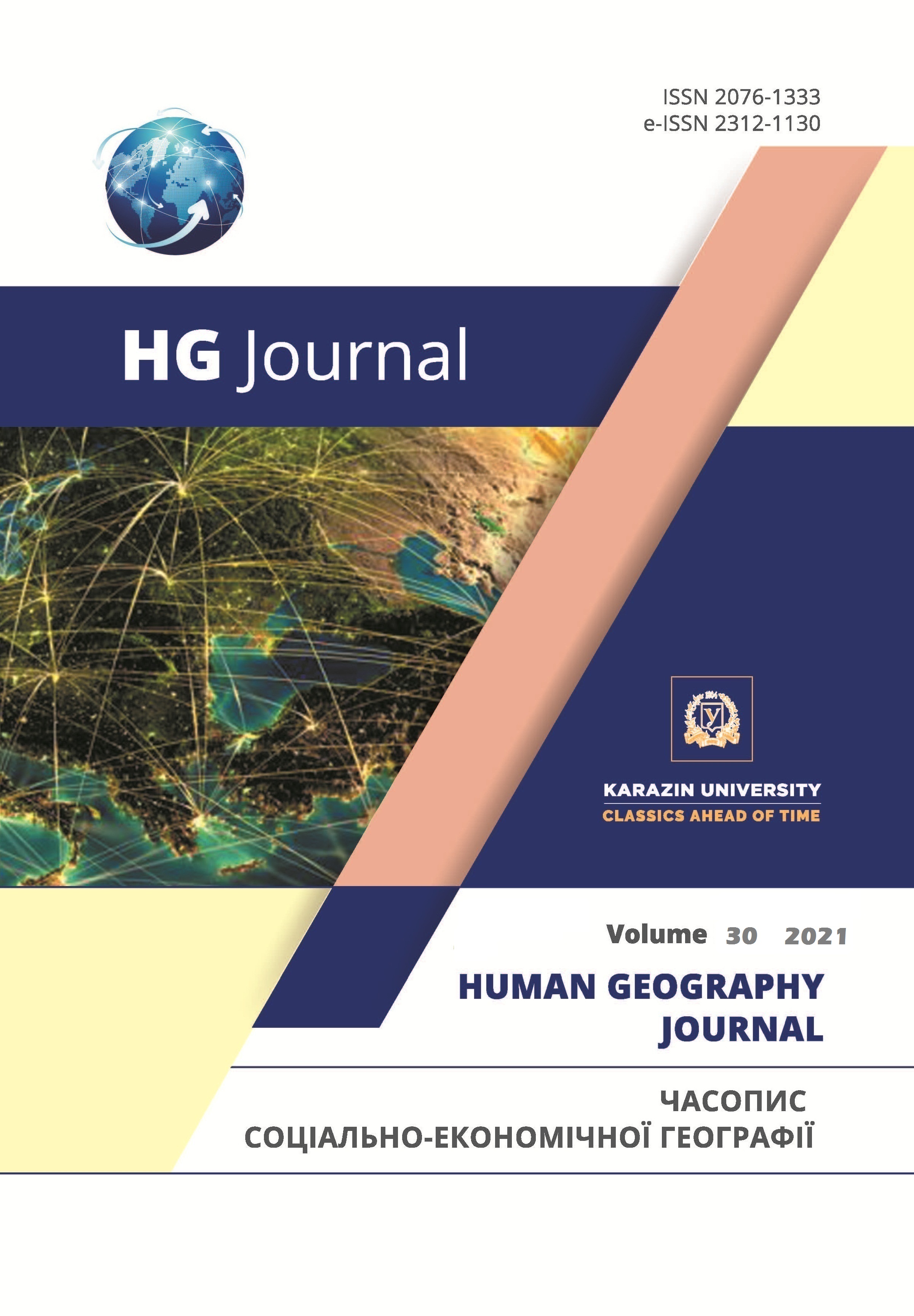Internal factors of the geodemographic process (on the example of fertility in the regions of Ukraine)
Abstract
The urgency of demographic problems in Ukraine is growing, which contributes to the aggravation of the demographic crisis. Considering the population of the state as a single geodemographic system, understanding the degree of regional differentiation of the birth rate due to specific conditions and factors, determine the characteristics of the internal factors of self-organization of the geodemographic system, including one of the geodemographic processes - birth rate. Among the internal factors of change in the birth rate is the structural and age-related birth rate. The article, based on the analysis of official statistics, establishes the temporal features of the dynamics of the birth rate in Ukraine, identifies the periods of minimum (1999-2002, 2018-2020) and maximum values (2011-2012) to determine the degree of internal factors to change the overall indicator. Using the method of standardization of demographic coefficients, the degree of influence of population structure and age, intensity of births on the change in the birth rate in terms of regions of Ukraine was determined. During the study period there was a change in the age structure and change in age-specific fertility rates, which led to a significant impact on the change in fertility, but the degree of influence of each of these factors for the studied regions is different.
Considering the influence of internal factors on the change in the birth rate, we note that the increase in the birth rate in 2002-2012 is primarily the result of changes in the age-specific birth rate, including an increase in middle and older fertile groups (+ 40%); decrease in the birth rate in 2012-2018 - changes in the age structure of the population, in particular decrease in the population in the younger groups of fertile age (-11.5%). The assessment of the influence of internal factors for the whole period shows negative changes in the population structure and the revival of reproductive behavior in middle and older age groups of women. With the help of statistical analysis the place of peculiarities of influence of each of the internal factors determining the birth rate in the context of the regions of Ukraine is determined, the revealed structural and dynamic features of the birth rate in the regions of Ukraine are outlined.
Downloads
References
Oppenheimer, V.K. (2001). Social Demography: Role of Inequality and Social Differentiation. International Encyclopedia of the Social & Behavioral Sciences, Pages 14270-14276. https://doi.org/10.1016/B0-08-043076-7/02086-6
Aksyonova, S.Yи. (2019). Osoblyvosti narodzhuvanosti u zhinok serednioho viku [The relation of the mean age of women at childbearing and fertility rate]. Demography and Social Economy, 2 (36), 23-38. https://doi.org/10.15407/dse2019.02.023 [in Ukrainian].
Demografichnyi pasport terytorii regioniv Ukrainy [Demographic passport of the territory of the regions of Ukraine]. Retrieved from http://database.ukrcensus.gov.ua/Mult/Dialog/statfile1_c_files/pasport1.htm [in Ukrainian].
Derzhavna sluzhba statystyky Ukrainy [State Statistics Service of Ukraine]. Retrieved from http://www.ukrstat.gov.ua/ [in Ukrainian].
Krimer, B.О. (2018). Transformatsiya narodzhuvanosti v Ukraini na rannikh etapakh demohrafichnoho perekhodu [Fertility changes in Ukraine during the early stages of demographic transition]. Demography and Social Economy, 2 (33), 67-81. https://dse.org.ua/arhcive/33/5.pdf [in Ukrainian].
Kurylo, I.O. (2019) Strukturni kharakterystyky narodzhuvanosti, yikh vzaiemozviazky ta demohrafichni faktory dy-namiky [Structural characteristics of fertility, their connection and demographic factors of dynamics]. Demography and social economy, 1 (35), 11-25. https://doi.org/10.15407/dse2019.01.011 [in Ukrainian].
Mezentseva, N., & Kondras, N. (2015). Druhyi demohrafichnyi perekhid: vytoky ta kontseptsii [Second demographic transition: origins and concepts]. Ekonomichna ta Sotsialna Geografiya, 73, 51-56. https://doi.org/10.17721/2413-7154/2015.73.51-56 [in Ukrainian].
Segida, E. (2020). Strukturno-dynamicheskie osobennosti rozhdaemosti v Ukraine v XXI veke [Structural-dynamic features of fertility in Ukraine in the XXI century]. Mogilev: Mogilevskaya oblastnaya ukrupnennaya tipografiya imeni Spiridona Sobolya, 1-2 (49-50), 21-26 [in Russian].
Sehida, K. (2017). Suspilno-geografichna kontseptsiya geodemografichnoi systemy regionu [Human-geographical con-cept of the regional geodemographic system]. Human Geography Journal, 22(1), 53-61. https://doi.org/10.26565/2076-1333-2017-22-09 [in Ukrainian].
Sehida, K.Yu. (2021). Metodychni osnovy vyznachennya vplyvu strukturnykh chynnykiv demohrafichnykh protsesiv [Methodological bases for determining the influence of structural factors of demographic processes]. Problems of Continuous Geographic Education and Cartography, 32, 72-80. https://doi.org/10.26565/2075-1893-2020-32-08 [in Ukrainian].
Sehida, K.Yu., & Karaichentseva, H.A. (2020). Regionalni osoblyvosti vidtvorennya naselennya Ukrainy [Regional features of the population reproduction of Ukraine]. Socio-geographical factors of regional development, 72-76. https://dspace.uzhnu.edu.ua/jspui/bitstream/lib/29054/1/zbirnyk_SG_chynnyky_20.pdf [in Ukrainian].
Copyright (c) 2021 Kateryna Sehida, Hanna Karaichentseva

This work is licensed under a Creative Commons Attribution 4.0 International License.




